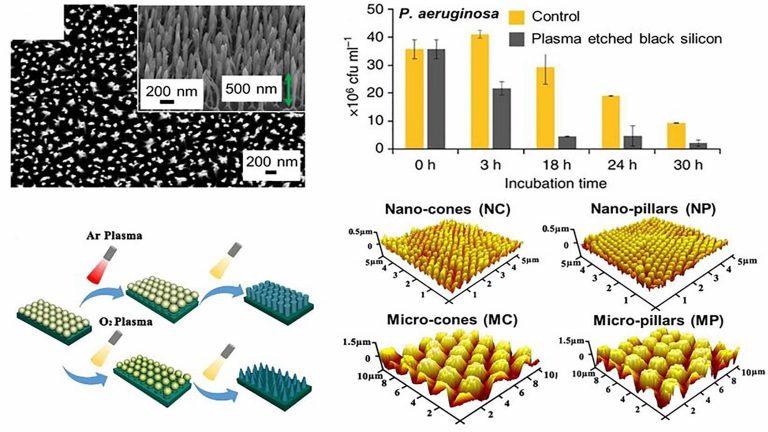Over the past few years, the intensifying worry over antibiotic-resistant infections, linked with prevalent hospital-acquired infections from surgical tools, heavily touched surfaces and implants has accelerated antimicrobial material development.
 Plasma-etched nanostructured anti-bacterial surfaces. Image Credit: Copyright 2020 Elsevier.
Plasma-etched nanostructured anti-bacterial surfaces. Image Credit: Copyright 2020 Elsevier.
Utilizing conventional wet-chemistry techniques to create biocidal materials seems to be complicated, costly and tedious. In the study reported in the Journal of Applied Physics, by AIP Publishing, scientists from Belgium, the Czech Republic and Italy present a tutorial in which they examine a hopeful alternative known as plasma-enabled surface engineering.
Plasma-based engineering is an inexpensive and environmentally friendly method, because it doesn’t require the use of solvents and can be scaled up to industrial production relatively straightforwardly.
Anton Nikiforov, Study Co-Author, Ghent University
The technology depends on non-equilibrium plasma, or partially ionized gas, generating chemical reactions to alter the properties at the material surface. The different temperature levels within the plasma — generally ionized noble gases, air or oxygen — make distinct chemical pathways. Reactions can be influenced by adjusting electric power for coating deposition, surface activation and surface nanostructuring of almost any solid material.
Contact-killing, antifouling and drug-release surfaces can be created by plasma-enabled engineering. Contact-killing materials tend to destroy microorganisms via the microscopic spikes that puncture microorganisms when touched.
One study demonstrated that plasma-etched black silicon nanopillar structures that are extremely bactericidal against a range of bacteria, such as Staphylococcus aureus, an antibiotic-resistant bacterium that is popular for causing a serious skin infection that can also affect the bloodstream, bones, heart and lungs.
Antifouling materials inhibit microbes from housing on surfaces to develop biofilms and other hazardous microbial surroundings. Some of these materials have gained motivation by what nature has already invented, like the antifouling properties of cicada and dragonfly wings, which are made up of nanopillars that can kill microorganisms on contact and generate biochemicals to repel moisture.
Plasma polymerized superhydrophobic thin coatings (water-repelling materials motivated by the lotus leaf) have also been widely produced and examined for their antifouling properties. With the absence of moisture, the microbes are prevented from clinging to and reproducing on the surfaces.
Drug-release surfaces regulate the discharge of antimicrobial compounds, allowing high-dose delivery of antibiotics to targeted locations, which seems to be useful following surgery. For instance, vancomycin, a common antibiotic, was deposited within spherical particles. This was made possible in aerosol-assisted plasma deposition, which integrates drug aerosols and high-energy plasma.
Several plasma-based methods have been developed to produce such surfaces, along with plasma polymerization, sputtering, low-pressure and atmospheric pressure plasma etching, aerosol-assisted plasma deposition, gas aggregation of nanoparticles and numerous combinations of the same techniques.
Even though plasma-based engineering is certain to expedite, there are still difficulties to overcome, which include the requirement to better comprehend how bacteria stick to surfaces and what happens when the microorganisms are destroyed.
Journal Reference:
Nikiforov, A., et al. (2021) Plasma technology in antimicrobial surface engineering. Journal of Applied Physics. doi.org/10.1063/5.0066724.